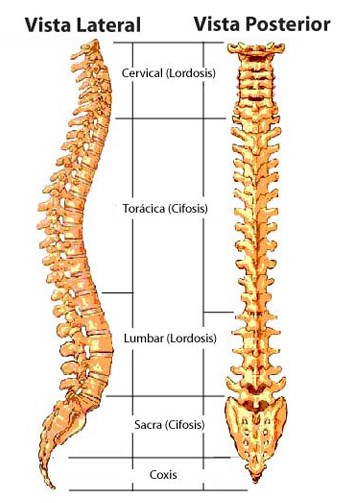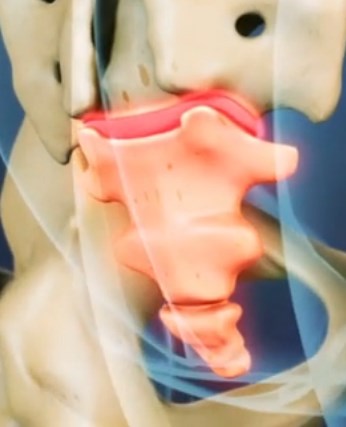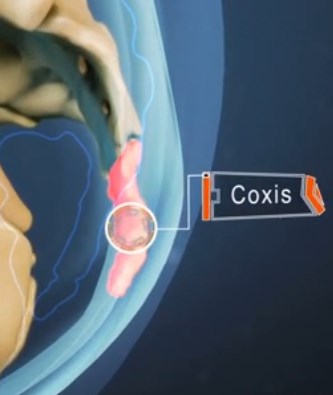Coccydynia, coccydynia or coccygodynia is a pain in the ácoccyx area, due to inflammationóstructure no. óbe located at the very base of the vertebral column. The coccyx are the úlast bones (3 o más) merged at the end of the spine.
This conditionón is quite rare and perhaps little known, characterized by persistent pain in the lower spine, usually worse when sitting.
It can range from a brief discomfort to a sharp pain in the ligaments and tendons around the tailbone.. Each individual perceiveá pain differently.
This lower back pain is más común in women than in men. onceón is because the coccyx has different movements between both sexes. In men the hip is a little más straight and the sacrum rotates inward, in women, the hip leans forward so the sacrum rotates outward. Then when sitting, women fix their weight on the coccyx, what makes them más prone to coccygodynia.
Pain can change over time, can last toñand later worsen.

Index
Causes of a coccydynia
 Range of motion of the tailbone is limited, moving above this range presents coccygodynia.
Range of motion of the tailbone is limited, moving above this range presents coccygodynia.
The causes can be diverse, like for example afterés of a caíand, afterés of childbirth, afteréI know of a surgeryíthe simply prácontinuous sports that are performed sitting like cycling, equitationón, etc.
in the majoría of the cases can be presented by an unstable or dislocated coccyx, which leads to inflammationón crónica.
SpaghettiéThe following conditions may not cause coccygodynia:
Coxis rístiff or too long. A long tailbone is more likely to suffer dañor in comparisonón with a short one. Al sir rígido will haveá less range of motion, leading to bursitis.
Muscle spasms and contractures. Muscle areas strongly againstídays close to the coccyx, that produce pain.
Neuropatípudendal nerve. Not really a coccydynia, but it can be the cause of pain when sitting.
Pilonidal cyst. It is an abscess that forms under the skin and is very close to the sacrum, prónext to the intergl foldúteo.
Tarlov cyst. They are masses that are filled with spinal fluid and that form at the end of the spinal cord. The pain starts when éthey exert pressureón on the spine.
Cáncer. It's little likeún find tumors in this area, however it is possible. These tumors are not seen on radiography.ías, need an MRIética or a CAT scan (Scannerícomputerized axial) to detect them.
Dolor neuropático. It is a pain caused by the nervous system itself, due to dañyou are on the nerves for some injuryón.
Diagnócoxygodynia stich
Depending on the conditionópatient no., the doctor can order tests and exáMenes as X-rayícoccyx, CT or MRIétics to confirm the diagnosisócoccygodynia stico.
Sísymptoms of coxygodynia
 He sísymptom of coccygodynia that reigns is pain at the end of the spine, these can be presented as:
He sísymptom of coccygodynia that reigns is pain at the end of the spine, these can be presented as:
- Persistent pain in the lower back that is aggravated by receiving pressureón.
- Pain that increases when sitting.
- pain that arises with stressñand that is relieved by evacuating.
- Pain that increases with change of positionón sitting standing.
Treatments for coccygodynia
 Treatments to relieve coccydynia, It will depend on the cause and severity of the síntomas.
Treatments to relieve coccydynia, It will depend on the cause and severity of the síntomas.
The best treatment is not to sit for long periods of time. when sitting dutyá do it on a padded base that minimizes pain. Plenty of rest is recommended to speed recovery.óno of coccyx.
Non-steroidal anti-inflammatory drugs and/or analgesicséPhysicians help to alleviate the afflictionón. If the pain is very intense, you can resort to local cortisone injections or a guía fluoroscopica.
The applicationón of a compress fríin the coccyx area, helpá to reduce pain. If you don't have pads, the ice tooécan't help. Some specialists, Conversely, recommend warm compresses.
In the case that the coccyx pain is due to dietary causes, well be starñbloating or intestinal gas, you should start changing your diet, consume más fiber and water.
can be tried tooén with chiropr treatmentsáctics or use teaétechnique for stretching the ligaments around the coccyx, but only supervised by a physiotherapist or a chiropractoráskeptic.
If the cause of the pain is a tumor in the área, then you should proceed with an interventionón wantúrgica.
Only in extreme cases is the coccyx removed, what is known as coxigectomía. Not recommended, because as time passes it will weakenán the múdogs pélvic and can lead to a perineal hernia.
recommendations
Once the pain has been relieved enough to move freely, you should start doing aerial exercisesólow impact bibs. Following a daily workout, achieveá an increase in blood flowíneo, what Brigá I get nutrients that stimulateáno and accelerateán healing processes in the coccyx.
